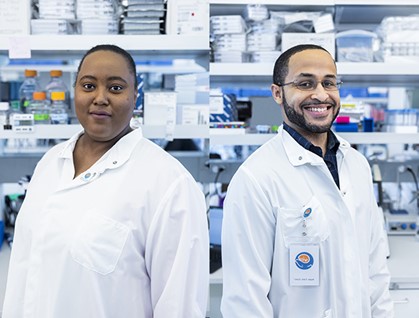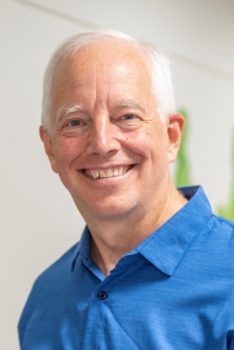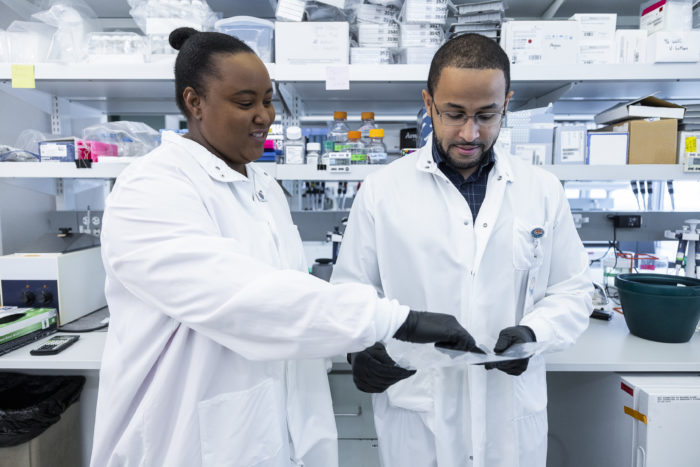Seattle Children’s Research Institute Creating ‘On-ramp to Biotech’ for Early Career Scientists
6.14.2022 | Joy Jernigan
 Drs. Alison Williams (left) and Eric Nealy are helping to build a program at Seattle Children’s Research Institute for early career scientists who have historically been excluded from or underrepresented in biotech.
Drs. Alison Williams (left) and Eric Nealy are helping to build a program at Seattle Children’s Research Institute for early career scientists who have historically been excluded from or underrepresented in biotech.
Seattle Children’s Research Institute today announced the Invent at Seattle Children’s Postdoctoral Scholars Program, a $45 million investment in training early career scientists historically underrepresented in biotech in the development of therapeutics for childhood conditions. Seattle Children’s has pledged to raise an additional $10 million for the program.
“We want to create an on-ramp to the biotech sector for people who have traditionally not had that opportunity,” said Dr. Jim Olson, program director.
The research institute’s investment includes a $12.5 million grant from the Washington Research Foundation – the largest single-program grant in its 40-year history – to support 10 scholars per year, or 50 total over the next five years. Scholars will receive a $65,000 annual starting salary plus benefits, a $10,000 professional development fund, and education in inventorship, entrepreneurship, and biotech approaches to team science. Initial appointments are for three years, with funding opportunities for two additional years to bridge to either an academic appointment or a biotech position. Up to $5 million in technology commercialization grants is available to scholars.
A recent article in the scientific journal Nature found that fewer early career scientists are landing jobs as principal investigators in academia, highlighting the need for training scientists for careers beyond an academic setting.
“Over half of all PhDs go into industry, but we really don’t teach them how to go into biotech,” Olson said. “We don’t teach them how to do team science, how to make go/no go decisions. This program will offer that.”
Advancing Scientific Breakthroughs
Scientists from racially and ethnically diverse backgrounds, women, and those who identify as LGBTQ+ have historically been underrepresented or excluded in biotech. Too often, doctoral and postdoctoral training programs tend to favor candidates who had access to early internships, multi-generation alumni connections and other privileges, Olson said.
 Dr. Jim Olson
Dr. Jim OlsonTo counter this historical approach, which Olson believes reinforces systemic racism, the Invent at Seattle Children’s program is upending the application process to focus on a candidate’s potential, motivation, natural curiosity, creativity and commitment to building their knowledge. Applications will be accepted on a rolling basis.
The program’s goal is to train new scientific leaders to develop therapeutics specifically for children, as drugs approved for adults often do not work as well in pediatric patients.
Seattle Children’s is uniquely positioned to lead development of new therapeutics for childhood conditions such as cancer, sickle cell disease, immune diseases and more. The institute has the infrastructure in place, with a 11,000-square-foot Therapeutics Cell Manufacturing Facility that follows Good Manufacturing Practices (GMP) and a 4,700-square-foot VectorWorks GMP facility for manufacturing cell products for early phase clinical trials.
In the 15 years since the formation of its research institute, Seattle Children’s scientists have discovered cellular therapeutics, gene therapies and protein therapeutics that have led to dozens of clinical trials and the formation of 14 biotech companies.
A Sense of Belonging
Dr. Eric Nealy is a postdoc in Olson’s lab who has wanted to be a cancer researcher since he was 14 years old. Cancer has touched his life personally. His mother is a breast cancer survivor, and his father died of pancreatic cancer.
Nealy grew up in South Los Angeles in a neighborhood nicknamed “The Jungles.” Violence, drug use and gangs were not uncommon. Nealy stayed out of trouble because his family kept him busy studying or playing sports after school.
In college, Nealy noticed how few diverse faces were in the room, especially in his science, technology, engineering and math (STEM) classes.
Then Nealy participated in a Howard Hughes Medical Institute Gilliam Fellowship. “Now everyone around me is Black, Latinx, disabled, you name it. You concentrate us into one spot, and not only do the participants know, ‘Hey, we’re not alone in this,’ but it also eases some of that anxiety of, ‘Do I belong here?’”
Today, Nealy’s research focuses on using the immune system to attack brain tumors. He is recruiting students for informational discussions about the Invent at Seattle Children’s program.
Pairing Scholars With Mentors
Dr. Alison Williams, a research scientist in the Olson Lab who focuses on developing therapeutics for children with brain cancer, recruited the program’s biotech mentors.
Williams’ scientific career took an indirect route. “I enjoyed my science classes in high school, but chemistry was very challenging,” she said. She failed her high school class, but in college, she gave chemistry another try.
“My mentors in college, my professors, were so enthusiastic and so encouraging that I realized that I had a passion for chemistry,” Williams said. “And so I decided to pursue my master’s degree and my doctorate in chemistry.”
 Drs. Alison Williams (left) and Eric Nealy encourage students interested in science to follow their dreams.
Drs. Alison Williams (left) and Eric Nealy encourage students interested in science to follow their dreams.
Her sister is a cancer survivor, and after completing her doctorate, Williams wanted to switch fields from chemistry to cancer research. “I wanted to do research that directly helps people,” she said. She found it challenging to find a position in cancer research until she joined Olson’s lab.
“His mentorship was truly life-changing and has allowed me to continue my career as a scientist today,” Williams said.
Each Invent at Seattle Children’s scholar will have a laboratory, clinical and biotech mentor from organizations such as Seattle Children’s Research Institute, the University of Washington, Benaroya Research Institute, Fred Hutchinson Cancer Center and biotech companies. Candidates will identify mentors early in the application process and work with them to develop a proposal that focuses on cellular, gene or protein therapeutics for children. If a lab is not a good fit, scholars have the opportunity to find placement in a new lab.
The program also includes educational opportunities for each scholar to learn about drug discovery and development, intellectual property, and technology commercialization at the University of Washington or the University of California, San Diego.
“We’re really setting them up to be successful and to make sure they have business knowledge,” said Dr. Amanda Jones, senior director of Education Initiatives and assistant program director for the Invent at Seattle Children’s program.
Follow Your Dreams
Nealy believes the Invent at Seattle Children’s program is a step toward providing more opportunities for young scientists from diverse backgrounds. More diverse representation in biotech contributes to better health outcomes for all patients.
“Continue following your dreams,” Nealy said. “There are many ways to get out of the situations we’re born into. Popular options include entertainment, sports, music, things like that, but it’s not for everybody. If you actually like school, and if you want to become a doctor or a scientist, that’s also a viable option for you.”
Just keep going, Williams advises young scientists. “When you accomplish your goals, you’re going to appreciate your successes so much more because of your determination,” she said. “There is a place for you in science.”